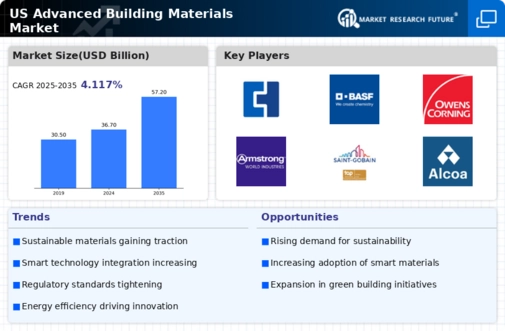Urbanization Trends
Urbanization is a significant driver of the Global US Advanced Building Materials Market Industry. As populations migrate to urban areas, the demand for housing and infrastructure escalates. This trend necessitates the use of advanced materials that can meet the challenges of urban construction, such as space constraints and sustainability requirements. The market is projected to expand significantly, reaching 541.32 USD Billion by 2035, as urban centers evolve. Advanced building materials, including lightweight composites and modular construction solutions, are increasingly favored for their efficiency and adaptability. Consequently, urbanization is likely to remain a critical factor influencing market dynamics.
Market Growth Projections
The Global US Advanced Building Materials Market Industry is poised for substantial growth, with projections indicating a market value of 541.32 USD Billion by 2035. This growth trajectory is underpinned by a compound annual growth rate (CAGR) of 7.84% from 2025 to 2035. Such figures suggest a robust demand for advanced materials driven by urbanization, sustainability, and technological advancements. The market's expansion reflects the increasing integration of innovative materials in construction practices, which are essential for meeting modern building standards and consumer expectations.
Technological Innovations
Technological advancements play a pivotal role in shaping the Global US Advanced Building Materials Market Industry. Innovations such as 3D printing, smart materials, and nanotechnology are revolutionizing construction processes. These technologies enhance the performance and durability of building materials while reducing waste. For example, smart materials can adapt to environmental changes, improving energy efficiency. The market is expected to grow at a CAGR of 7.84% from 2025 to 2035, indicating a robust trajectory fueled by continuous innovation. As construction firms increasingly adopt these technologies, the demand for advanced materials is likely to surge, further propelling market growth.
Sustainability Initiatives
The Global US Advanced Building Materials Market Industry is increasingly driven by sustainability initiatives. As environmental concerns rise, there is a growing demand for materials that minimize carbon footprints and enhance energy efficiency. For instance, the adoption of recycled materials and sustainable sourcing practices is becoming prevalent. This shift not only aligns with regulatory frameworks but also appeals to environmentally conscious consumers. The market is projected to reach 235.94 USD Billion in 2024, reflecting the industry's commitment to sustainable development. Companies that prioritize eco-friendly materials are likely to gain a competitive edge, as sustainability becomes a key differentiator in the construction sector.
Government Regulations and Incentives
Government regulations and incentives significantly impact the Global US Advanced Building Materials Market Industry. Policies aimed at promoting energy efficiency and reducing greenhouse gas emissions are driving the adoption of advanced materials. For instance, various states offer tax incentives for the use of sustainable building materials, encouraging construction firms to invest in innovative solutions. These regulations not only foster a more sustainable construction environment but also stimulate market growth. As the industry adapts to comply with these regulations, the demand for advanced materials is expected to rise, contributing to the overall expansion of the market.
Consumer Preferences for Energy Efficiency
Consumer preferences are increasingly shaping the Global US Advanced Building Materials Market Industry. There is a notable shift towards energy-efficient building solutions as homeowners and businesses seek to reduce energy costs and environmental impact. Advanced materials that enhance insulation and energy performance are in high demand. This trend is reflected in the market's projected growth, with an anticipated value of 235.94 USD Billion in 2024. As consumers become more informed about the benefits of energy-efficient materials, manufacturers are likely to innovate and expand their offerings, further driving market dynamics.














Leave a Comment